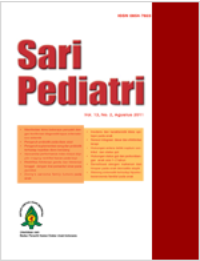Karakteristik Dan Luaran Tumor Otak Pada Anak
Sari
Latar belakang. Morbiditas dan mortalitas tumor otak pada anak masih menjadi masalah yang besar. Seringkali manifestasi klinis yang jelas muncul pada saat tumor dalam stadium lanjut. Saat ini luaran tumor otak di Indonesia masih belum memuaskan meskipun telah dilakukan berbagai terapi operatif maupun konservatif. .
Tujuan. Mengetahui karakteristik dan luaran pasien tumor otak pada anak di Rumah Sakit Hasan Sadikin Bandung (RSHS).
Metode. Dilakukan secara deskriptif retrospektif dengan data pasien tumor otak pada anak berusia < 18 tahun yang datang ke RSHS pada periode 1 Januari 2012 - 31 Desember 2018.
Hasil. Selama penelitian terdapat 161 subjek dengan 88 pasien (54,6%) laki-laki. Tumor otak terjadi paling sering pada kelompok usia 6-12 tahun sebanyak 66 pasien (41%). Sebanyak 73 pasien (46,5%) memiliki tumor otak di area supratentorial, 80 pasien (51%) memiliki tumor di area infratentorial, dan 4 pasien (2,5%) memiliki tumor di area suprainfratentorial. Hasil patologi anatomi terbanyak yaitu meduloblastoma pada 36 pasien (22,3%), dengan derajat keganasan VI (46,5%), dengan manifestasi klinis paling sering adalah sakit kepala (64,5%). Pada pemeriksaan neurologis didapatkan parese saraf otak paling sering adalah gangguan nervus kranialis II (34%) dan hemiparesis (20,5%). Ditemukan pula adanya reflek patologis pada 55 pasien (34%). Hasil luaran paling banyak dari data yang tersedia adalah perbaikan dalam gejala klinis (60,3%).
Kesimpulan. Meduloblastoma merupakan jenis tumor otak yang tersering (22,3%), pada anak dengan sakit kepala sebagai manifestasi paling banyak.
Kata Kunci
Teks Lengkap:
PDFReferensi
Levin VA, Leibel SA, Gutin PH. Neoplasms of the central nervous system. Dalam: DeVita VT Jr, Hellman S, Rosenberg SA, penyunting. Cancer: principal and practice of oncology. Edisi ke-6. Philadelphia: Lippincott Williams & Wilkins; 2001.h.2100-60.
Hamilton W, Kernick D. Clinical features of primary brain tumours : a case – control study using electronic primary care records. Br J Gen Pract. 2007;57:695-9.
Bauchet L, Rigau V, Mathieu-Daudé H, Fabbro-Peray P, Palenzuela G, Figarella-Branger D, dkk. Clinical epidemiology for childhood primary central nervous system tumors. J Neurooncol 2009;92:87.
Bishop AJ, McDonald MW, Chang AL, Esiashvili N. Infant brain tumors: incidence, survival, and the role of radiation based on surveillance, epidemiology, and end results (SEER) Data. Int J Radiat Oncol Biol Phys 2012;82:341-7.
Suresh SG, Srinivasan A, Scott JX, Rao SM, Chidambaram B, Chandrasekar S. Profile and outcome of pediatric brain tumors - experience from a tertiary care pediatric oncology unit in South India. J Pediatr Neurosci 2017 ;12:237-44.
Kheirollahi M, Dashti S, Khalaj Z, Nazemroaia F, Mahzouni P. Brain tumors: Special characters for research and banking. Adv Biomed Res 2015 6;4:4
Daras M, Kaley TJ. Benign brain tumors and tumors associated with phakomatoses. Continuum (Minneap Minn) 2015;21:397-414.
Rutka JT, Ph D. Malignant brain tumours in children : Present and future perspectives. J Korean Neurosurg Soc 2018;61:402-6.
Lo G, Ramis R, Tamayo-uria I, Go D, Morales-piga A, Romaguera EP, dkk. Risk factors for central nervous system tumors in children: new findings from a case-control study. PLoS One 2017;17:12.
Hobbie WL, Ogle S, Reilly M, Lucas MS, Ginsberg JP, Fisher MJ, dkk. Adolescent and young adult survivors of childhood brain tumors: life after treatment in their own words. Cancer Nurs 2016 ;39:134-43.
Glod J, Rahme GJ, Kaur H, Raabe EH, Hwang EI, Israel MA. Pediatric brain tumors: current knowledge and therapeutic opportunities. J Pediatr Hematol Oncol 2016;38:249-60.
Katchy KC, Alexander S, Al-nashmi NM, Al-Ramadan A. Epidemiology of primary brain tumors in childhood and adolescence in Kuwait. Springerplus 2013;2:58.
Sánchez-Sánchez LM, Vázquez-Moreno J, Heredia-Delgado JA, Sevilla-Castillo R. Clinical presentation of supratentorial and infratentorial intracranial tumors in pediatric patients]. Gac Med Mex Spanish 2016;152:158-62.
Comelli I, Lippi G, Campana V, Servadei F, Cervellin G. Clinical presentation and epidemiology of brain tumors firstly diagnosed in adults in the Emergency Department: a 10-year, single center retrospective study. Ann Transl Med 2017;5:269.
Sarica FB, Cekinmez M, Tufan K, Sen O, Onal HC, Mertsoylu H, dkk. Five-year follow-up results for patients diagnosed with anaplastic astrocytoma and effectiveness of concomitant therapy with temozolomide for recurrent anaplastic astrocytoma. Asian J Neurosurg 2012;7:181-90.
Siregar MH, Mangunatmadja I, Widodo DP. Clinical, radiological, and histopathological features and prognostic factors of brain tumors in children. Dalam: Journal of Physics: Conference Series. IOP Publishing; 2018.h. 32039.
Spector R, Snodgrass SR, Johanson CE. A balanced view of the cerebrospinal fluid composition and functions : focus on adult humans. Exp Neurol 2015;273:57-68.
Girardi F, Allemani C, Coleman MP, Supplement D. Worldwide trends in survival from common childhood brain tumors : a systematic review abstract 2019;1-25.
Widodo DP, Mangunatmadja I, Siregar M, Pusponegoro H, Handryastuti S, Soebadi A, dkk. Characteristics of pediatric brain tumors at department of child health faculty of medicine universitas Indonesia-Dr Cipto Mangunkusumo Tertiary General Hospital, Jakarta, Indonesia. Neurooncology 2020. Doi:10.1093/neuonc/noaa222.458.
DOI: http://dx.doi.org/10.14238/sp25.2.2023.87-92
Refbacks
- Saat ini tidak ada refbacks.
##submission.copyrightStatement##
##submission.license.cc.by-nc-sa4.footer##
Email: editorial [at] saripediatri.org


Sari Pediatri diterbitkan oleh Badan Penerbit Ikatan Dokter Anak Indonesia
Ciptaan disebarluaskan di bawah Lisensi Creative Commons Atribusi-NonKomersial-BerbagiSerupa 4.0 Internasional.




